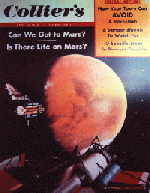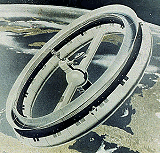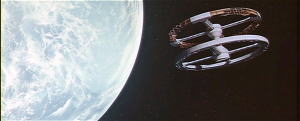宇宙ステーション、政治政略に翻弄 2003/07/22 ヒューストンクロニクル記事 (編集者コメント:この記事にはステーションに関して歴史的視点で、その意義を再確認させてくれる内容となっている。プログラム開始当初の関係者へのインタビューを交えて、本来のステーションの意義を「どこかへ行くためのステップ」と結論付けている。微小重力実験がステーションを取り巻く話題の中心となりがちな日本では、ステーションの存在意義を問われたときに、微小重力実験、地球観測、通信といった内容だけでは、明確な答えを導き出すことは出来ない。有人宇宙探査を言及することがタブー視される日本風土、日本文化の中で、ステーションプログラムの継続意義を明確にしないと、プロジェクトを中止せよとの圧力が強まることが懸念される。しかしながら、100年後の世界に、このプロジェクトが与える期待可能な影響を想像したときに、現在のこの開発行為の重大さが認識されるものと思われる。 クリントン大統領時代に、ロシア経済復興の支援、自由主義経済へのロシア加盟、頭脳流出の防止、中産階級の増加等の目的で、ステーションプログラムへのロシア参加を米国は支援した。また、米国としては、ソ連の宇宙ステーション”ミール”で培ったノウハウを必要としていた。このような国際政治的背景から、ステーションプログラム実現の効率は悪化することを承知で、ロシアを引き入れた経緯がある。米国からすると、世界戦略から見た場合に、ステーションプログラムによって発生する赤字分は、他の国際的戦略で十分黒字になれば十分埋め合わせが可能と判断しているのではないだろうか。) |
|||||||||
| 技術的には地球ではない場所で生活する二人の孤独な男たち、エド・ルーとユーリ・マレンチェンコは、毎日の作業日は電話で始まる。アラバマにいる彼らの上司は今日の雑用を要約して電話で二人に伝える。その後の8時間は時速1万8千マイルで空を突進しながら、国際宇宙ステーションを構成する一連のカプセルに閉じ込められながら、彼らは様々な作業をこなす。 スペースシャトル運行は停止しており、ステーションは未完成のまま、取り残されているなかで、彼らは長期滞在乗組員として作業を続ける。状況は理想とはまったく異なる。本来は乗組員は7人の予定であったが、ロシアと米国の科学者二人は最善を尽くしている。宇宙における人間の役割を維持しようと奮闘するNASAはそこに彼らがいることをうれしく思っている。 ルーとマレンチェンコは歴史上最も高価な公共事業の管理人となっている。あるいは、個人的な見方によるが、無敵の科学技術上の業績とみるか、寿命が続く間、決して調整されることの無い$100bの資金が惜しまず注ぎ込まれる将来の宇宙ゴミと見ることも出来る。両方共、可能性のある見方である。 NASAのこれまでのいかなるプロジェクトもこれほど挑戦的でコストのかかるものは経験していない。2年前に初めて人間が乗り込み、しかしいまだに完成していないステーションは、NASAのビジョンだけではなく、NASAの大型プロジェクトに対する資金運用能力に対する批判をかわす避雷針的役割になっている。スペースシャトルプログラムは中傷者の矛先の一部に組み込まれているが、特にコロンビア号の事故以来、特に厳しく批判される対象となっているが、その痛烈な批判の拡大でも、ステーションバッシングには及ばない。 米国物理学会の元広報担当で物理学者であるロバート・パークは、「ステーションは歴史上で最大の科学技術上の大失敗である。」と述べている。「これまでこれほどの費用を投じた大失敗は見たことが無い。何かを学習しようとするためには障害物となっている。重大な研究に使用されるべき資金をがつがつと食い物にしている。何が間違っていると言えば、多くのことをやろうという考えでステーションを建設したことである。」 パーク氏は有人宇宙プログラムに対して容赦なしの評論家であり、膨大なコスト投入の割にはわずかな科学的価値しか回収しないと不満を表している。しかしながら、その批評の背景には、彼の友人で、当初から彼の脳裏を引っ掻き回している宇宙政策専門家から、偉大なミッションとして評価したり、無益な回り道としてステーションを見なしている元宇宙飛行士までの広範囲からの意見が参考となっている。後に、「可能な限りの最悪な嫌悪感」として表現している。 このような考え方は、最終的な結論を示唆しているが、宇宙ステーションはこのような批判に対抗できる状態ではなく、事実、ステーションを建設するための論理的基盤は変更しつづけているし、予算超過のためにクルーの人員も削減され、ステーションを正当化するための最後の砦とも言える研究機能も低減されている。NASA当局が執拗に勧める潜在的な科学的利益でさえも、$30Bを超える予算超過という不明瞭な予算管理によって不透明感が増す結果となっている。 元NASA副長官のハンス・マーク氏は、ステーションの支持者の一人であったが、「現在のISSは我々が心に描いていたものとは異なり、以前はもっと小規模で全ての付属機能も無かった。現在はより大規模でより複雑になっている。我々はステーションの原型に戻るべきで、小規模であり、そこで生活できるだけの施設があれば十分。」と述べている。 マーク氏が描いていたステーションでは、小規模の研究室が含まれているが、話の内容は、長くて困難にみちた初期の開発物語である。最初の発想から最終設計に至るまで、変化する経済状態や地政学的潮流にマッチさせるために、様々な形に修正されていった。NASA監督機関の希望が常に考慮され、政治的な動機付けが際立っていた。 NASAはステーションプログラムがスタートしたその日から宇宙ステーションを希望していたし、無関心派や多くの対抗勢力に何年も我慢してきた。ステーションは、1950年代にフォン・ブラウンが描きだした宇宙征服のためのオリジナルロードマップの一部であった。その中では、ステーションに搭乗している人間以外全ては地球に戻すというものであった。これが最初の宇宙基地のイメージであった。 この夢は1980年代初期までは休眠状態となっていた。しかし、シャトルプログラムの初飛行が間近に迫り、新しい大統領が就任した。この時点で、シャトルプログラムに続く大規模宇宙プロジェクト計画が無かったことが、懸念事項となった。そして、突然、事態が急変した。シャトルを打上げるとすると、シャトルが向かう場所や乗務員がすべき作業が必要となり、軌道を周回するステーションの建設の正当性が認識され始めた。 議会の中には、懐疑論者もいたが、同時にNASAの大型プロジェクトを、選出された地元にもってくることを考える数百人の議員もいた。このような議員にとっては、プロジェクトの科学的意義や内容は、地元への経済的効果よりもさほど重要ではなかった。宇宙に人間を滞在させるという高価な技術プロジェクトは、米国のすみずみまでお金をばらまくという意味では人気があった。 元共和党議員のリチャード・ツインマー氏は、その辺のからくりを直接経験した人物でもある。彼は、宇宙分野に興味があったため、下院宇宙小委員会に1991年から1997年まで出席をしていた。NASAからは彼の地元にはほとんど資金が流れてこなかったが、ツインマーが即座に学んだことは、他の委員会メンバーにとってはそうではなかった。 「ジョージ・ブラウン(?)が私に言った言葉に、”この国は大規模な公共事業が必要で、その中には宇宙も含まれるべきである”。」とツイマンーが述べている。下院科学委員会委員長を例にして、「宇宙ステーションはお手盛り政府事業として首尾よく実施された。委員会の職員が非公式に私に言ったのは、ステーションは結局はNASAによるベトナム戦争と同じというものなんだ。しかしステーションが提案された時点では航空宇宙産業にとっては生命維持装置のようなものであった。つまり、全ての努力は議会を通して資金を獲得することだった。”」と語っている。 今日、NASAのショーン・オキーフ長官は科学的意義のあるものとしてステーションを賞賛している。地球では実現不可能な微小重力環境での実験は、生物医学や材料科学分野での研究では大きな可能性を秘めていると述べている。 科学分野では、この点について疑問視している。ホーリ・クロス大学の物理学教授マシュー・コスは、これまでにシャトル実験ミッションで3回の実験を行っており、当然、この実験の支持者と見るべきであるが、一方で、ステーションは重大な実験に専念できる研究者の数と作業時間が余りにも少なすぎると主張している。あるケースでは、クルーの作業は自動式実験装置の設置だけという場合もある。 「宇宙探査の実験と混同しないでおこう。科学実験という言葉には2種類が存在する。」とコス氏が語った。彼は最小限の科学的成果のために人間を滞在させる危険をおかすという意識そのものを問題視している。」「シャトルとステーションは有人宇宙探査に関連する分野にとっては必要と思う。しかし科学にとっては必要ではない。ほとんどの実験は十分に自動化が可能である。」 つまり、これは科学者の論理であり、もちろん政治家の論理ではない。 人間が脳裏に栄光を夢見てロケットの頂上に座るよりずっと以前に、宇宙征服の青写真は一般の想像を駆り立てていた。計画では人間が宇宙にただ打上げられるだけではなく、地球軌道にステーションを建設することも含まれていた。そして月にも基地を建設し、火星にも飛行する大型の宇宙船も描かれていた。ある計画について、1952年から1954年の間に発行された雑誌「Collier's」(注:一般向けSF雑誌)では6回にわたり特集された。各記事は、イラストや技術的な情報もふんだんに使って詳細に描かれていた。
著者はもちろんフォン・ブラウンであった。彼はドイツのロケット技術者で、米国軍のミサイルプログラムに参加したことや、宇宙探査を促進するテレビ番組に頻繁に登場した為に、米国では一躍有名人となった。 ブラウンは、直径250フィートで車輪のような形状をし、人工重力を発生させるために回転させる宇宙ステーションを提案した。収容するクルーは80人で、基本的な目的は月や惑星探査ミッションのための中継基地、或いは乗り継ぎ基地であった。ブラウンのステーションは、スタンリーキューブリックが監督した映画「2001年宇宙の旅」に出てくるステーションのモデルにも使われた。 これ以外に提案されたステーションとしては、キューブリックの映画の原作となる本の著者であるアーサー・C・クラークの案も含まれる。何年も前に、クラークは通信の目的で一連のステーションを軌道上に配置することを提案した。この案には人間が搭乗することが前提となっていたが、その理由は単純そのもので、ステーションに搭載されているラジオの真空管を交換するためというものである。 衛星やトランジスタがクラークの想像に追いつくずっと以前に、宇宙ステーションは実現可能なものとして描かれ始めた。ステーションとシャトルは一緒のものとして考えられていたが、予算や政治といって現実的な問題によって、これらの計画を棚上げにする力が働いていた。1972年にニクソン大統領が就任すると、シャトルプログラムがNASAの全てとなった。 1980年にレーガン大統領が就任すると、事態は大きく変化した。大統領ブレーンの中の宇宙専門家グループは、NASAは支持出来ない状態であり、明確な目的と方向性が無いとの結論を出した。この結果を受けて、数ヵ月後にNASA長官として(民間企業から)ジェームズ・ベグ氏を迎えるための道を開くこととなった。これは、宇宙ステーションが宇宙プログラムにおける”次の論理的ステップ”ということを新しい大統領に確信させるためのお膳立てであった。 ベグは、レーガン政府の上級メンバーにはステーションの支持に対して柔軟であることに気付いていた。しかし、彼は、もし大統領の前でステーションを提案できれば、ステーションは米国の成長を拡大し、スペースステーション開発ではソ連が先行していることに注目させることができると確信していた。 ベグ氏は、NASAとの口述歴史プロジェクトで行われた最近のインタビューで、「レーガンは(ステーション計画を)支持していた。彼はなぜ彼がNASAを好きになったのかその理由さえも知らなかったが、とにかく彼はNASAを支持した。」と思い出しながら語った。 1984年1月の一般教書で、レーガンはNASAに対して恒久的有人宇宙ステーションを建設することと、その実現を10年以内に実施するようNASAに指示を出したと、ちょうどジョン・F・ケネディーのようなスタイルでステーションプログラムを発表した。 そうする中で、レーガンは、彼の科学アドバイザであるジョージ・キーワースの意見に反対した。キーワースは、ステーション計画は、他のより有益な科学的探究に使用される資金を湯水のごとく注ぎ込むことになると考えていた。キーワースは、レーガンがこの計画を支持したのは単に政治的判断のみであったと述べている。1984年は選挙の年であり、対立候補はジョン・グレンであった。ジョン・グレンは、アメリカで最初の宇宙飛行士であり、英雄でもあった。 NASAは、この野心的プロジェクトは$8Bで実現できると、当時の下院予算小委員会議長で疑念を抱いていたエドワード・ボランドに対して主張していた。「ステーション計画が開始され、運用開始される時に私が関わっているかどうかは知らないが、もし賭けをするなばら、$8Bよりもコストがかかるほうに賭けるね。」と述べている。 ボーランドは、結局2001年に死去する前に儲けを手にしなかったが、彼は借りを作ったことになる。NASAが非現実的数字でもってシャトルプログラムを促進しているときに、ステーション全体のコストが提示された。それは、NASAが議会と戦うと考えているゲームのようでもあった。 元民主党議員でミシガン出身のボブ・トラクスラーは、NASA予算を審議する委員会に参加したが、「故意に安く見積もるというNASAの文化が理解されていた。」と、1993年のヒューストンクロニクルとのインタビューで語っている。「打上げコスト、サービスコスト、維持管理コスト、そして維持管理するために必要な数十年間に渡る打上げ回数などについて誰も話題にしなかった。」と述べている。 NASAが1972年にシャトルを手に入れたとき、それが最善の宇宙船でなくてはならなかった。NASAは信じられないほどの経済的可能性を強調した。そして高価な火星有人ミッションに関連するどの計画からもシャトルプログラムを切り離した。 ステーションに関しても同様であった。建造するための論理的正当性として火星を語ることはタブーであった。その代わりに恒久的な有人の軌道上研究室や、地球観測向けのプラットフォームといった当り障りの無いものとして誇大宣伝されたが、最終的にはコストに見合った価値のあるものとは言えなかった。惑星探査にむけた施設としての意味合いは語られなくなり、それ以外のものとして理解されることになった。 ベグ長官時代の副長官であったマークは、「最初の2年間はこれを正当化するためにえらく苦労したよ。本当の正当化は段階を追って行われた。」と語る。マークは現在はテキサス大学で航空宇宙工学教授となっている。このミッション毎への段階的正当化は結局は明らかにされていない。 冷戦時代に誕生したステーションの進化の過程では、経済や管理問題、そして絶えず変化する要求条件に伴って影響を受けてきた。政治的な論理基盤を表している初期の名前は”フリーダム:自由”であったが、自由主義国家の国際的結束を表すシンボルであった。リーガン政権の第1期の終わり頃には、米国を中心とした12カ国によって本格的な国際的宇宙ステーションとなった。ソ連はそのメンバーではなかった。 1993年にクリントン大統領が就任するまでには、ステーションは5回にわたる再設計が行われた。冷戦が終結し、シャトルチャレンジャーが爆発事故を起こし、米国の宇宙飛行士は、ロシアの宇宙ステーション”ミール”にロシア宇宙飛行士と共に地球を周回することになった。その段階で宇宙ステーションは”アルファ”と呼ばれており、唯一過去に描かれた青写真に存在していた名前である。 クリントンが大統領に就任した年に、この悩ましいプロジェクトは中止を目的として議会で投票が行われたが、1回の投票で生き残った。ツインマーは下院委員会メンバーで唯一反対した人物であった。科学委員会議長のロバート・ウォーカはステーションを支援しなければならないと考えていた。 「ウォーカは、私にこう言ったんだ。”見てみろ、これは唯一の選択肢なんだ。最善の選択ではないが、ほかに何が出来るって言うんだね?”」とツインマーが述べている。「大部分の宇宙小委員会メンバーは、経済的効果が短期に終わったとしても、いいことであると自ら信じていたよ。もし君の選挙区に関係し、経済的効果があれば、ステーションは良いことだと信じるための理由をみつけるだろうね。」 米国が資金を提供し、ロシアが製造した最初のステーションモジュール”ザーリャ”。このモジュールを打上げるまでにはその後5年間を要した。打上げはかつての悪魔の帝国から行われた。最下級民族からパートナへの変身は1995年に開始され、現在では完全に変身している。 ロシアの参加は、効率性が生命線であったこのステーションプログラムに巨大な弾丸を打ち込むこととなった。スペースステーションは現在ではイデオロギー的には自由となり、名前も”国際宇宙ステーション”へと改名された。 ロシアの存在によって、ステーションにおいて政治的な意味での新たな論理的基盤が発生してきた。また、ロシアの宇宙科学者がソ連崩壊以降、大規模な失業問題が浮上し、彼らの能力を世界市場の中で販売しなければならない事態となった。場合によっては悪者の国に彼らの能力が流出することも懸念された。そして、議会では、ステーションの年間予算を長期的な視点で年間$2.1Bに固定することを承認することが妥当とする予算上限設定案を支持する議員が増加していった。 かつてのような裕福な時代は終焉した。ロシア経済の崩壊により、ロシアの公約を経済的理由で遅れさせる結果となった。最初のクルーが2000年最後に日に打上げられるまでに、ステーションは苦境のどん底にあった。 2002年、会計検査院(GAO)は、「NASAはスペースステーションプログラムによって重大な局面に遭遇している。コストの増加によって、プログラムは当初意図した目的を十分に実現することが出来ないし、これは本質的問題である。」と報告している。 この報告書を書いたGAOのアレン・リー氏は、今日でさえも、ステーションが完成した時点で一体コストがどこまで膨らむのか、誰もいえないと述べている。的を得るために、NASAが言っている”中核部分の完成:Core Complete”でも、$30Bを超えると見られている。 リー氏はインタビューで、「国際パートナはクルーの人数を制限することに快く思っていないことは明らかである。そしてシャトル飛行が長期にわたって遅れることになると、ステーションのスケジュールは更に長くなり、常備人員を維持し、さらにコストが膨れることも明らかである。」と述べている。 ステーションに滞在するクルーの人数は、ステーションの運用や有意義な科学的実験を予定通りこなすために必要な最低限の人数として7人が必要と考えられていた。オキーフが管理不能状態のコストを抑制することを使命としてNASA長官に指名されたとき、彼はクルーの人数を3人に削減することに時間を割かず、ほぼ完成間近だったX-38を中止する命令を下した。X-38は、7人のステーションクルーを非常事態の時に地球に無事帰還させるための$1.3Bのプロジェクトであった。 NRC(学術研究会議)によって昨年発行された報告書では、米国の科学者は、ステーションのクルー人数を削減することによって意義のある科学的研究を支援する能力を著しく損なうとして、このような変更に対して警鐘を鳴らした。 オキーフ長官は、ステーションの研究上の可能性は依然として高いと信じている。長期間の宇宙飛行の間に人間に起こりうる物理的プロセスに答えを見つけることによってステーションは研究にとっておおいに役立つと述べている。要は、長期間微小重力環境の中では人間の筋肉や骨が衰退する現象を指している。 しかしながら、NRCの報告書では、削減された研究時間とクルー人数によって研究作業の質が著しく低下すると結論付けた。問題解決の方法としては、ステーションの能力を追加することである。オキーフ長官は最終的には機能拡張を予想している。 これだけではステーションに対する批評家を満足させることは出来ないであろう。もしNASAが次の段階に進まず、地球低軌道を越えて、さらなる宇宙探査のための従属施設としてステーションを再定義しないならば、長期的な未来は無いと、報告書は予測している。 クリントン大統領の元科学アドバイザーのニール・レーン氏に、「なぜ我々は人間を宇宙に送り込むのですか?」と問い掛けたところ、彼は、「答えは科学を行うためではない。答えは、他の何かでなくてはならない。宇宙ステーションは、どこかに進むためのステップでなければならない。」と答えた。 |
Space station had political ties in tow Every working day begins with a telephone call for Ed Lu and Yuri Malenchenko, the two loneliest men on Earth. Or technically, not on Earth. Their bosses in Alabama are on the line to give them a rundown of the day's chores. For the next eight hours, as they hurtle across the sky at 18,000 mph, they will go about performing them while locked in a series of capsules that composes the international space station. With the space shuttle grounded and the station unfinished, they are the total onboard crew. The situation is far from ideal -- originally there were supposed to be seven people on board -- but the Russian and U.S. scientists do the best they can. NASA, struggling to maintain the role of humans in space, is happy to have them there. Lu and Malenchenko are the latest caretakers of the most expensive public works project in history, which, depending on your point of view, is either an unrivaled technological achievement or a piece of future space junk that will never justify a fraction of the estimated $100 billion to be lavished on it over its lifespan. It may, of course, be both. No NASA project has been so challenging or so expensive. First occupied two years ago but still not completed, the station has been a lightning rod for critics who challenge not only the agency's vision but also its ability to fiscally manage large projects. The space shuttle program has its share of detractors, especially after the loss of Columbia and its crew on Feb. 1, but the extent of their vitriol cannot match that of the station bashers. "It's the biggest technological blunder in history," said Robert Park, physicist and former spokesman for the American Physical Society. "I can't think of any blunder that has cost as much. It is an obstacle to learning anything. It gobbles up the resources that could be used for serious study. What we did wrong was build a station with the idea there would be a lot of things to do on it." Park is a relentless and predictable critic of human space programs, complaining that they return little of scientific value for their enormous costs. In this cause, however, his allies range from space policy gurus who have scratched their heads since the start, to members of Congress who have supported other space projects, to former astronauts who saw the station as a useless detour from a greater mission. One of the latter refers to it as "an abomination ... the worst thing possible." Though prudence suggests reserving final judgment, the space station has enjoyed no such immunity, in part because the rationale for building it kept changing and in part because continual cost overruns forced reductions in crew size and the ability to do research -- the station's final justification. Even the potential scientific gains touted by current NASA officials will have a hard time obscuring the monumental expense -- pushing $30 billion so far -- or the strong whiff of pork. "This is not what we had in mind," said Hans Mark, a former NASA deputy administrator who was one of the station's original proponents. "The one we proposed was smaller without all the crap on it. It is now bigger and much more complicated. We should have gone back to the original version and built it small, just as a place to live." Mark's version also included a laboratory, albeit a smaller one, but his point speaks to the installation's long and troubled genesis. From first thought to final design, it was pushed and squeezed into various incarnations to match shifting economic and geopolitical tides. The wishes of the space agency's overseers always had to be considered and political motives served. NASA wanted a space station from almost the day it was founded, and it persevered through years of indifference and legions of opponents. A station was part of the original road map to space conquest laid out by Wernher von Braun in the 1950s. Everything else with people on board came back to Earth. This was the first outpost. The dream lay dormant until the early 1980s, as the shuttle program was closing in on its first flight and a new president was entering office. The prospect of having no large space project to follow the shuttle became a real concern, and suddenly the timing was right. An orbiting station made sense because it gave the shuttle somewhere to go and its passengers something to do when they got there. Though Congress had its share of skeptics, it also had hundreds of members who had seen large NASA projects reach into their districts. For those members, the scientific content of the project was less important than its impact back home. Expensive engineering projects that keep astronauts in space are popular because they spread money into virtually every corner of the country. Former U.S. Rep. Richard Zimmer, R-N.J., saw firsthand how it worked. He sat on the House space subcommittee from 1991 to 1997 because he had an interest in the subject. Little if any NASA largess found its way to his district, but as Zimmer soon learned, that was not true for most of his fellow committee members. "George Brown told me that this country needs large public works projects and that some of them should be in space," Zimmer said, referring to the chairman of the House Science Committee. "The space station was successfully sold as a pork-barrel project. A staffer on the committee told me off the record that this would end up being NASA's Vietnam. But at the time it was proposed, it was life support for the aerospace industry. That's where all the muscle came for getting it through Congress." Today NASA Administrator Sean O'Keefe lauds the station's significance as a scientific asset. By possessing conditions unavailable on Earth -- microgravity -- there is great potential for biomedical and materials research, he said. The scientific community has doubts about that. Matthew Koss, a physics professor at Holy Cross College, has had three experiments performed on shuttle missions and should be an advocate. Instead, he argues that the station has too few people and hours devoted to serious research. In some instances, the crew's only purpose is to deploy an autonomous experiment. "Let's not mix scientific experimentation with space exploration -- they're two different things," said Koss, who questions the morality of putting people's lives at risk for minimal scientific gain. "The space shuttle and the space station may be necessary for a range of issues related to the manned exploration of space. But they are not necessary for science. Most experiments can be fully automated." That's the logic of a scientist, of course. Not a politician. Long before man ever sat atop a rocket with dreams of glory in his head, a blueprint for space conquest had already been imprinted on the public imagination. The plan showed humans not just blasting into space but building way stations in Earth orbit, bases on the moon and large ships to fly to Mars. One version of this scheme occupied six issues of Collier's magazine from 1952 to 1954. Each article was lavishly illustrated and technically comprehensive. The author was von Braun, the one-time German rocketeer who was becoming a household name in the United States because of his involvement with the Army missile program and appearances on television promoting the exploration of space. He proposed a space station 250 feet across that looked like a wheel and spun so it could produce artificial gravity. Housing a crew of 80, its primary purpose was as a point of embarkation for lunar and planetary missions. Von Braun's station was the model for that depicted by film director Stanley Kubrick in 2001: A Space Odyssey. Others had proposed space stations, including Arthur C. Clarke, author of the book upon which Kubrick's movie was based. Years before, Clarke envisioned a series of them placed aloft for communications purposes. They would have to have people on board for a simple reason -- someone had to change the broken vacuum tubes of the radios. Long after satellites and transistors overtook Clarke's vision, the space station began to emerge as a real possibility. Though the space shuttle and station had been conceived together, budgetary and political reality had forced the agency to shelve its plans for the latter. President Nixon announced in 1972 that the shuttle was all that NASA would get. Things began to change after the election of President Reagan in 1980. A group of space experts appointed by his transition team concluded that the space agency was in an untenable position, once again without a clear purpose and direction. That paved the way for James Beggs, who was appointed NASA administrator a few months later, to set about convincing the new president that a space station was "the next logical step" for the space program. Beggs was aware that support for the station among senior members of Reagan's administration was soft, but he believed if he could get a proposal before the president, he had a shot at convincing him the space station would enhance the United States' stature and would begin to address the Soviet Union's lead in space station development. "He was very supportive," Beggs recalled in a recent interview for NASA's Oral History project. "He didn't know why he liked NASA, but he did." In his January 1984 State of the Union address, Reagan announced in Kennedy-esque style that he was directing NASA to build a "permanently manned space station and to do it within a decade." In doing so, Reagan went against the opinion of his science adviser, George Keyworth, who believed the station would drain money from more worthwhile scientific pursuits. Keyworth said the only reason Reagan endorsed it was political: 1984 was an election year and John Glenn, the senator from Ohio and America's first space hero, was a potential opponent. NASA claimed it could finish the ambitious project for $8 billion, prompting Edward Boland, the skeptical chairman of the House Appropriations subcommittee, to remark: "I don't know whether I will be around when it is launched or operating properly, but I will bet you a hat, if you wear one, that it is going to cost a lot more than $8 billion." Boland may not have gotten a hat before he died in 2001, but he was owed one. Just as NASA had promoted the space shuttle with unrealistic figures, it offered a bare-bones price tag for the station with many known costs omitted. It was a bit like a game that NASA felt it had to play with Congress. "There was an understanding in the NASA culture that you low-balled numbers," said Bob Traxler, a former Democratic congressman from Michigan who sat on the committee that appropriated funds for NASA, in a Houston Chronicle interview in 1993. "Nobody talked about launch costs, service costs, maintenance costs and the necessary launches over decades to maintain it." When NASA got the shuttle in 1972, it had to justify the spaceship as best it could. First the agency hyped the economic potential almost beyond belief. Then it dissociated the shuttle from any plans for an expensive human mission to Mars. Ditto for the space station. Using Mars as a rationale to build it was taboo. Instead it was touted as a permanently manned orbital laboratory and as a platform for Earth observation -- not bad things to have, but ultimately not worth the cost. The planetary implications were not spoken, but they were understood. "For the first two, you have a hard time justifying it," said Mark, Beggs' deputy administrator and now an aerospace engineering professor at the University of Texas. "The real justification was as a staging base." A staging base for a mission that has never shown up. Born in the waning years of the Cold War, the station's evolution was forced as much by history as economics, management problems and ever-changing requirements. Its political rationale, reflected in its original name, Freedom, was to demonstrate the international solidarity of the world's free countries. At the end of Reagan's first term, it was a full-fledged international operation, led by the United States and involving 12 allied nations. The Soviet Union, by design, was not a member of the club. By the time President Clinton took office in 1993, the station had undergone five redesigns. The Cold War was over, the shuttle Challenger had blown up and American astronauts were spinning around Earth with their cosmonaut colleagues on a Russian space station called Mir. The U.S. space station, now named Alpha, existed only in blueprints. That year, the beleaguered project survived by one vote an attempt in Congress to kill it. Zimmer was the only member of his committee to vote against it. Science Committee Chairman Robert Walker believed he had to support it. "Walker told me, `Look, this is the only game in town. It's not the best thing, but what else can we do?' " Zimmer said. "Most of the (space subcommittee) members convinced themselves it was a good thing, even if the economic benefit was short-term. If it's in your district and there's an economic benefit, you will get to the point where you believe in it." It would be another five years before the first piece of hardware, a U.S.-funded, Russian-built module called Zarya, was launched into orbit from the former Evil Empire. Russia's transformation from pariah to partner, begun in 1995, was complete. Russia's involvement was a huge shot in the arm for a program that effectively was on life support. It meant the space station was now ideologically free, and its name was changed to the International Space Station. The Russian presence gave the station a new political rationale. It also gave Russian space scientists, largely out of work since the collapse of the Soviet Union, something to do besides being forced to to sell their skills, possibly to unsavory nations, on the global market. And it increased congressional support to the extent that lawmakers saw fit in 1995 to approve long-term funding, fixed at $2.1 billion a year. The honeymoon, such as it was, did not last. The collapse of the Russian economy caused costly delays in their commitments. By the time the first crew was launched in the last days of 2000, the station was in dire straits. In 2002, the General Accounting Office reported that "NASA is at a critical juncture with the space station program. Because of the cost growth, the program is essentially unable to carry out the full intent of its original objectives." The man who wrote the report, GAO official Allen Li, said that even today no one can say with certainty what the station will cost when it is complete. To get it to the point NASA terms "Core Complete" would likely cost in excess of $30 billion. "It's quite clear that the international partners are not happy about the limitations on crew size," Li said in an interview. "It's also clear that if there is any long-term delay in shuttle flights, the schedule will be lengthened and with the standing army we have, it's obviously going to be more costly." The station was supposed to have accommodated a crew of seven -- considered the minimum number of people needed to operate it and still have time to do meaningful science. When O'Keefe was named NASA administrator with a mandate to bring costs under control, he wasted no time in reducing the crew size to three and abolishing the nearly complete X-38, a $1.3 billion project to provide an emergency return ship for the larger station crew. In a report last year by the National Research Council, an arm of the National Academies, the country's scientists warned that the changes, particularly the reduction in crew size, drastically impaired the space station's ability to support meaningful scientific research. O'Keefe remains committed to the station's research potential. It will serve exploration, he said, by helping provide solutions to the debilitating physical processes that occur to humans during long-duration spaceflight. These include loss of muscle and bone mass. The Research Council report, however, concluded that the decreased research time and smaller crew will significantly limit the quality of work that can be done. The solution is to add capacity back into the station. O'Keefe predicts expansion will happen eventually. That alone will not satisfy the station's critics. If NASA does not go a step further and make the station's mission subservient to a greater one, a destination beyond low Earth orbit, they predict it has no long-term future. "Why are we flying humans into space?" asked Neal Lane, former science adviser to President Clinton. "The answer is not to do science. The answer has to be something else. The space station ... needs to be the step to somewhere." |
||||||||


